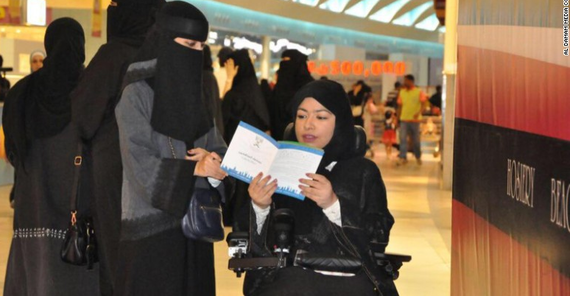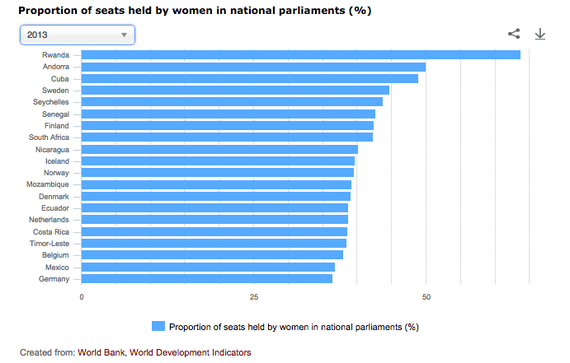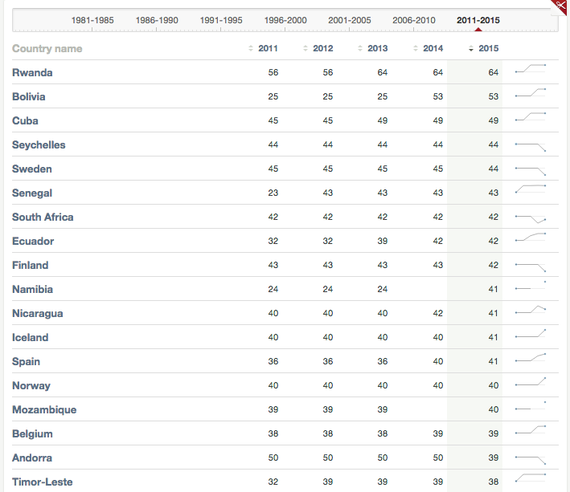
"Women distribute leaflets to raise awareness among citizens to participate in the upcoming municipal elections on August 21 in Al Dammam, Saudi, Arabia. Photo originally appeared on CNN.com."
Over the weekend, women in Saudi Arabia were able to vote for the first time, as well as participate in local elections as candidates.
Yep, you read that right. Until Saturday, women in Saudi Arabia weren't able to run for elected office, let alone vote. (Women in Saudi Arabia still aren't able to legally drive and their "male guardians" can stop them from traveling, marrying, working, studying, and more.) In their first ever election, 900 women ran for office in Saudi Arabia, and around 17 female councilors were elected.
This is 95 years after women in the United States won the right to vote with the 19th Amendment, and 122 years after the first nation allowed women to vote, New Zealand. (Go New Zealand!) By the way, women in the Vatican City still can't vote. (Hey guys, time to break tradition right? It's 2015?)
The historic election in Saudi Arabia comes on the tail end of Canadian Prime Minister Justin Trudeau's announcement that yes, half of his Cabinet ministers are FEMALE. Justified because, well, it's 2015 and do you need more justification than that?
While the Canadian Cabinet will now be 50 percent female, in the U.S., our current administration is less than 30 percent female (four of 15 Cabinet members) and women make up just 19 percent of the U.S. Congress.
Compare that to a few other countries:
- Sweden: The ministry is 53 percent female and their Parliament is 43 percent women.
Bolivia: 53 percent female Parliament. Finland: Finland's ministry is 42 percent female. Cuba: 49 percent female Parliament. Rwanda: Their Parliament is 64 percent female.
I don't see the United States on this list. Credit: The World Bank.

Proportion of women holding seats in national parliaments. See the entire list at The World Bank. Scroll to the bottom of that list and you'll see there are 0 percent women-held seats in Quatar, Tonga, and MORE. Credit: The World Bank.
Just a reminder that we still have some glass ceilings to break, here in the United States and across the world.
If you're from Iowa and want to run for public office, check out 50-50 in 2020, a bipartisan group educating and encouraging females to become political leaders.
Support HuffPost
Our 2024 Coverage Needs You
Your Loyalty Means The World To Us
At HuffPost, we believe that everyone needs high-quality journalism, but we understand that not everyone can afford to pay for expensive news subscriptions. That is why we are committed to providing deeply reported, carefully fact-checked news that is freely accessible to everyone.
Whether you come to HuffPost for updates on the 2024 presidential race, hard-hitting investigations into critical issues facing our country today, or trending stories that make you laugh, we appreciate you. The truth is, news costs money to produce, and we are proud that we have never put our stories behind an expensive paywall.
Would you join us to help keep our stories free for all? Your contribution of as little as $2 will go a long way.
Can't afford to donate? Support HuffPost by creating a free account and log in while you read.
As Americans head to the polls in 2024, the very future of our country is at stake. At HuffPost, we believe that a free press is critical to creating well-informed voters. That's why our journalism is free for everyone, even though other newsrooms retreat behind expensive paywalls.
Our journalists will continue to cover the twists and turns during this historic presidential election. With your help, we'll bring you hard-hitting investigations, well-researched analysis and timely takes you can't find elsewhere. Reporting in this current political climate is a responsibility we do not take lightly, and we thank you for your support.
Contribute as little as $2 to keep our news free for all.
Can't afford to donate? Support HuffPost by creating a free account and log in while you read.
Dear HuffPost Reader
Thank you for your past contribution to HuffPost. We are sincerely grateful for readers like you who help us ensure that we can keep our journalism free for everyone.
The stakes are high this year, and our 2024 coverage could use continued support. Would you consider becoming a regular HuffPost contributor?
Dear HuffPost Reader
Thank you for your past contribution to HuffPost. We are sincerely grateful for readers like you who help us ensure that we can keep our journalism free for everyone.
The stakes are high this year, and our 2024 coverage could use continued support. If circumstances have changed since you last contributed, we hope you’ll consider contributing to HuffPost once more.
Already contributed? Log in to hide these messages.


